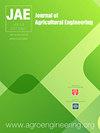Application of response surface methodology for optimisation of Cornelian cherry - Capia pepper leather dried in a heat pump drying system
IF 2.5
4区 农林科学
Q2 AGRICULTURAL ENGINEERING
引用次数: 0
Abstract
The heat pump drying system was optimised for cornelian cherry-capia pepper leather production development using response surface methodology. The central composite design was used to optimise the process parameters in terms of drying time, coefficient of the performance of heat pump, coefficient of the performance of the whole system, specific moisture extracted ratio, energy consumption, drying rate and colour values. The optimal condition of independent variables was obtained as a cornelian cherry pulp concentration of 47.419% and drying temperature of 33.574°C with composite desirability of 0.846. Moreover, hydroxymethylfurfural (HMF) and effective moisture diffusivity (Deff) values of all runs were analysed. HMF was not determined in cornelian cherry-capia pepper leather. Deff values of cornelian cherry-capia pepper leather were between 1.026×10-9 - 1.532×10-9 m2s-1. The drying behaviour of cornelian cherry-capia pepper leather with optimal conditions acquired with the central composite design was evaluated with seven thin-layer drying models. The statistical parameters based on R2, root mean square of error and χ2 values were determined between 0.8267 to 0.9845, 0.004087 to 0.035626 and 0.000853 to 0.066247, respectively. Page and Modified Page models were assumed to represent the heat pump drying behaviour of the cornelian cherry-capia pepper leather in thin layers compared to the other models.响应面法在热泵干燥系统中优化山茱萸-辣椒皮干燥的应用
利用响应面法对热泵干燥系统进行了优化,以适应山茱萸樱桃椒皮革生产的发展。采用中心复合设计对干燥时间、热泵性能系数、整个系统性能系数、比湿萃取比、能耗、干燥速率和色值等工艺参数进行优化。自变量的最佳条件为山茱萸果肉浓度为47.419%,干燥温度为33.574℃,复合理想度为0.846。分析了各批次的羟甲基糠醛(HMF)和有效水分扩散系数(Deff)。山茱萸樱桃椒皮中未测定HMF。山茱萸樱桃椒皮的缺省值在1.026×10-9 - 1.532×10-9 m2s-1之间。采用7种薄层干燥模型,对中心复合设计获得的最佳干燥条件下的山茱萸樱桃椒皮的干燥性能进行了评价。基于R2、均方根误差和χ2值的统计参数分别为0.8267 ~ 0.9845、0.004087 ~ 0.035626和0.000853 ~ 0.066247。与其他模型相比,假设Page和Modified Page模型代表薄层山茱萸樱桃皮的热泵干燥行为。
本文章由计算机程序翻译,如有差异,请以英文原文为准。
求助全文
约1分钟内获得全文
求助全文
来源期刊

Journal of Agricultural Engineering
AGRICULTURAL ENGINEERING-
CiteScore
2.30
自引率
5.60%
发文量
40
审稿时长
10 weeks
期刊介绍:
The Journal of Agricultural Engineering (JAE) is the official journal of the Italian Society of Agricultural Engineering supported by University of Bologna, Italy. The subject matter covers a complete and interdisciplinary range of research in engineering for agriculture and biosystems.
 求助内容:
求助内容: 应助结果提醒方式:
应助结果提醒方式:


